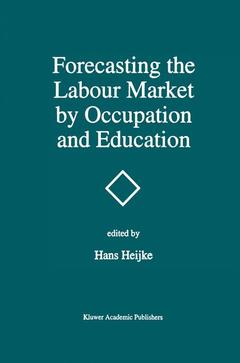Description
Forecasting the Labour Market by Occupation and Education, 1994
The Forecasting Activities of Three European Labour Market Research Institutes
Coordinator: Heijke Hans
Language: English
Subjects for Forecasting the Labour Market by Occupation and Education:
Keywords
Berufsforschung; Market research; Markt; education; equilibrium; labor market; labour; labour market; modeling
Publication date: 10-2013
210 p. · 15.5x23.5 cm · Paperback
210 p. · 15.5x23.5 cm · Paperback
Description
/li>Contents
/li>
Labour markets are differentiated by occupation and types of training, and these submarkets are seldom in equilibrium. This disequilibrium -- shortages and surpluses in labour markets -- is often attributed to a lack of flexibility in wage structures, the limited possibility for substitution between submarkets, and the high adjustment costs. In addition, market changes are difficult to foresee, thus making it equally difficult to respond appropriately.
This book contains the results of research from three major European institutes -- the Research Centre for Education and the Labor Market (ROA) at the University of Limburg in the Netherlands, the Institute for Employment Research (IER) at the University of Warwick in the U.K., and Institut für Arbeitsmarkt- und Berufsforschung (IAB) at the Bundesanstalt für Arbeit in Germany -- looking at how each institute conducts labour market forecasts by education and type of training. The common element of these institutes is their use of the manpower requirements method. The book is grouped into three parts -- Models and Methods, Forecasts, and Reflections -- with each institute presenting its results in each section.
This book contains the results of research from three major European institutes -- the Research Centre for Education and the Labor Market (ROA) at the University of Limburg in the Netherlands, the Institute for Employment Research (IER) at the University of Warwick in the U.K., and Institut für Arbeitsmarkt- und Berufsforschung (IAB) at the Bundesanstalt für Arbeit in Germany -- looking at how each institute conducts labour market forecasts by education and type of training. The common element of these institutes is their use of the manpower requirements method. The book is grouped into three parts -- Models and Methods, Forecasts, and Reflections -- with each institute presenting its results in each section.
List of Figures. List of Tables. Foreword. Introduction; H. Heijke. Part I: Models and Methods. 1. Modelling and Forecasting the Structure of Employment in the United Kingdom; R. Wilson. 2. Medium and Long-Term Forecasting of Employment in Germany; J. Fuchs, M. Tessaring. 3. Indicating the Future Labour Market Prospects of Occupational Groups and Types of Education in the Netherlands; R. Dekker, A. de Grip, H. Heijke. Part II: Forecasts. 4. Policy Implications of Recent IER Assessments of the British Labour Market; R. Lindley. 5. Manpower Requirements by Levels of Qualification in the Federal Republic of Germany until 2010; M. Tessaring. 6. The Market Position of Occupations and Types of Education in the Netherlands; R. van der Velden, E. Willems. Part III: Reflections. 7. A Perspective on IER Forecasting Activities; R. Lindley. 8. IAB's Medium and Long Term Labour Market Projections -- Selected Aspects; G. Kühlewind. 9. ROA's Activities and Plans relating to the Information System on Education and the Labour Market; H. Heijke.
© 2024 LAVOISIER S.A.S.




